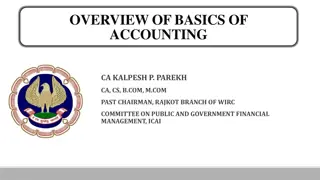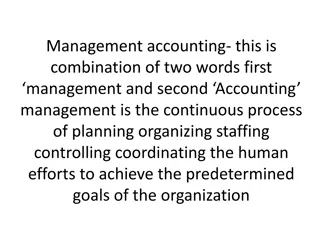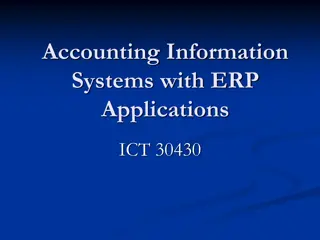Principles of Accounting Accounting
Discover the language of business with accounting principles, functions, and history. Learn the importance of accounting in various economic activities. Explore the role of accounting in tracking finances and making informed decisions for business sustainability.
Download Presentation

Please find below an Image/Link to download the presentation.
The content on the website is provided AS IS for your information and personal use only. It may not be sold, licensed, or shared on other websites without obtaining consent from the author.If you encounter any issues during the download, it is possible that the publisher has removed the file from their server.
You are allowed to download the files provided on this website for personal or commercial use, subject to the condition that they are used lawfully. All files are the property of their respective owners.
The content on the website is provided AS IS for your information and personal use only. It may not be sold, licensed, or shared on other websites without obtaining consent from the author.
E N D
Presentation Transcript
Principles of Accounting Accounting Dr. Madhu V Menon MATS School of Management Studies & Research
Syllabus MODULE I - Meaning and Scope of Accounting: Need for accounting, meaning, definition and functions, Book-Keeping and Accounting, Accounting Vs. Book-keeping Branches of Accounting, Users of accounts, Limitations of accounting, Parties interested in accounting information. MODULE II -Accounting principles and Accounting Equation: Accounting principles, Postulates, Doctrines, Axioms, Accounting Standards- introduction,Assumptions, Conventions and Concepts Double Entry System: Advantages and disadvantages, Debit and Credit, classification of Accounts, Accounting Equation with practical problems, Basic Accounting procedures - Journal, Ledger, Ledger posting, totalling and balancing of accounts, Opening entries
INTRODUCTION Accounting is the language of Business. Speaks how good is the business. Accounting is a summarizing business and financial transactions. The history of accounting civilization. Communicate the financial business to various stakeholders. system of recording and is as old as performance of
INTRODUCTION Accounting is required where money is used Accounting is equally important for all types of non business economic activities such school, municipalities, a charitable institution and even for a family. All are required to maintain accounts.
INTRODUCTION Over tremendous progress in the field of commerce and industry. Broadly speaking, accounting today is much more than just bookkeeping & the preparation of financial reports. Measurement of recording transactions and management with the use of data for making decisions is the two fundamental aspects the years accountancy has made
Need for Accounting Accounting plays a vital role in running a business. It helps you track income and expenditures. It is critical you keep your financial records clean and up to date if you want to keep your business afloat. Your financial records reflect the results of operations as well as the financial position of your business. It help you understand what s going on with your business financially. Accounting plays a critical role in all many scenarios.
Definition Accounting is the art of recording, classifying and summarizing in a significant manner and in terms of money, transaction and events, which are in parts at least of a financial character and interpreting the result = the American Institute of Certified public accountants
Functions The basic functions of accounting are: 1. Keeping financial records: 2. Monitoring financial transactions: 3. Making bill payments: 4. Paying employee salaries: 5. Writing financial reports: 6. Preparing budgets: 7. Making financial projections:
Book-keeping and accountancy Book Keeping is made of two words Book & Keeping. Where book means all types of books. Keeping means recording all the entries. It is used to record the business transaction in business business transactions in the accounts books in a systematic manner as per the rules and principle of accounts.
Book-keeping and accountancy Book-keeping is means An the art of recording the business transactions in the books of account of the business concern. Whereas, accounting is concerned with the formulation of principle to be followed in recording of business transaction. The major objective of booking is to enable a business firm to information accurately and with a minimum of time and effort. know the following
Accountancy Vs Book-keeping Accountancy Book-Keeping Management decisions based on the data obtained from accounting can take important Data provided by bookkeeping is not sufficient for decision making Financial statements are a part of the accounting process Not done in the case of bookkeeping No analysis is required in the bookkeeping Accounting analyses the data and creates insights for the business The person concerned with accounting is known as an accountant The person concerned with bookkeeping is known as a bookkeeper High-level understanding and analyzing accounting concepts learning required for No high-level learning required
Branch of Accounting What are the eight branches of accounting? 1. Financial accounting. 2. Cost accounting. 3. Auditing. 4. Managerial accounting. 5. Accounting information systems. 6. Tax accounting. 7. Forensic accounting. 8. Fiduciary accounting.
Limitations of Accounting Limitations of Financial Accounting 1. No Clear Idea of Operating Efficiency: 2. Weakness not Spotted Out by Collective Results: 3. No Classification of Expenses andAccounts: 4. Not Helpful in the Price Fixation: 5. No Data for Comparison and Decision- making 6. No Control on Cost:
Uses of accountancy Purpose of Accounting 1. Recording Transactions 2. Budgeting and Planning 3. Decision Making 4. Business Performance 5. Financial Position 6. Liquidity 7. Legal Requirements
Users of accountancy Users of accounting information. 1. Owners/Shareholders. ... 2. Managers. ... 3. Prospective Investors. ... 4. Creditors, Bankers, and other Lending Institutions. ... 5. Government. ... 6. Employees. ... 7. Regulatory Agencies. ... 8. Researchers
Accounting Principles Accounting principles are the rules and guidelines that companies and other bodies must follow when reporting financial data. These rules make it easier to examine financial data by standardizing the terms and methods that accountants must use. The International Standards is the most widely-used set of accounting principles, with adoption in 166 jurisdictions. Financial Reporting
Accounting Postulates An accounting postulate is an assumption in the field of accounting based on historical practice. Accounting postulates form the basis of the accounting standards transactions are treated and recorded. An accounting postulate example might be when revenue is recorded on an accrual basis or when earned and not when it's received. that govern how
Accounting Doctrines Accounting Doctrines and Conventions refers to set of rules, which are to be followed for obtaining objects of accounting. Here are the list of accounting doctrines and conventions: 1. Business entity concept: 2. Money measurement concept: 3. Cost concept (objective concept):
Users of accountancy 4. Consistency: 5. Conservatism : 6. Going concern concept: 7. Realization concept: 8. Accrual concept: 9. Dual aspect concept: 10. Convention of disclosure:
Accounting Standards An accountings standard is a common set of principles, standards, and procedures that define the basis of financial accounting policies and practices. An accounting standard is a set of practices and policies used to systematize bookkeeping and other accounting functions across firms and over time.
Accounting Standards Accounting standards apply to the full breadth of an entity s financial picture, including assets, liabilities, revenue, expenses, and shareholders' equity. Banks, investors, and regulatory agencies count on accounting standards to ensure information about a given entity is relevant and accurate. In the United States, the generally accepted accounting principles (GAAP) form the set of accounting standards preparing financial statements. widely accepted for
Double Entry System The double entry system of book-keep is the most satisfactory and a scientific system of maintaining the account of the business. Really speaking it is a complete accurate and perfect system of accounting which records both the aspects of each transaction. Every transaction has two aspects just as there are two parties to every contract.
Double Entry System Every business transaction has effect at least on two accounts. Whenever a businessman gives something he gets something else in return. It is these recording of the two fold effect of every transaction that has given rise to the term Double entry system here two entries are made for each transaction. Every debit accord to any account there is a corresponding credit to any other account.
Double Entry System 1. The advantages of Double Entry System are as follows: 2. It provides complete and reliable record of all business transactions because it records both the aspects. 3. It supplies full information about the incomes, expenses, assets and liabilities of the business. This helps the management in taking appropriate decisions. 4. The arithmetical accuracy of the books of account can be easily verified by preparing a trial balance. 5. The financial result of business organizations i.e: profit or loss, can be correctly ascertained. Advantage
Classification of accounts Every businessman requires the following the conduction to be fulfilled. 1. A businessman has to deal with large number of person. 2. He carries on business activities with the help of goods, furniture s, building and various other assets. 3. He has to incur certain expenses while carrying on his business.
Classification of accounts Therefore accounts are classified into three categories: 1. Personal account. 2. Real account. 3. Nominal account
Classification of accounts Personal account: account of individual firms limited companies, local authorities association with whom the businessman deals. Personal account are of three types 1. Natural personal account: Ex - Amit 2. Legal personal account: Ex Raja steel Ltd. 3. Representative Personal Account: Ex - MBA
Classification of accounts Real account: These are the account of properties assets or possessions of the businessman. Real account may assume the following two forms: 1. Tangible real account: Ex: Land 2. Intangible real account: Ex: goodwill
Classification of accounts Nominal account: These are accounts of expenses, income, losses or gains. These accounts are fictitious accounts as they do not represent any tangible assets. They exist only in name and cannot be seen or touched. A separate account is maintained for each head. Example: interest account, commission account discount account rent account etc. these account cannot be seen touched and hence they are unreal.
Classification of accounts Rules for different account for passing entries: Under the double entry system of account both the aspect of the transaction are recorded. The two aspects involved, receiving of value and giving of value of each transaction. The two aspects are distinguished in terms pod debit and credit. Debit is denotes by Dr and credit is denotes by Cr
Classification of accounts Example of Double Entry Book-keeping System Brought goods worth Rs 1,000/- from Shri Anand on credit. Here goods accounts will be debited. And Shri Anand account will be credit From the above example: we can see that there are two enterys. That is goods is moving into the business and cash is moving out from business to shri Anand
Journal Journal is derived from the French word Jour which mean a day. Journal therefore means a daily record. A journal is a book of original entry or primary entry . It is a book of daily records. First of all the business transactions are recorded in the journal. It may be divided into various books known as Subsidiary books for efficient transactions. To journalize the transactions mean to records the two fold effect of a transaction in terms of debit and credit. This has to be done by observing the rules of debit and credit.
Journal Importance of Journal The importance of journal is. Complete record of transaction: As both debit and credit aspects of each transaction are entered in the journal it provides complete information about the transaction that has taken place. Quick reference: Business transactions are recorded in the journal in the chronological order of the date. Hence it facilitates quick and easy reference to any transaction. Proper understanding: Narration of the transaction is given below each entry. It helps to have proper understanding of transactions recorded. Avoid the necessity of immediate posting: As the transactions are recorded in a systematic manner, there is no urgency to post them to the ledger. Ledger posting can be done at the convenience of the ledger clerk. Minimum errors: As debit and credit aspects of the transaction are recorded arithmetical accuracy can be ensured. If at all errors creeps in they can be located immediately
Journal Utility of a Journal. It contains a record of various transactions that take place every day. It provides a complete records of transaction as both the aspects of the transaction are recorded at one place. Since narration of a transaction is written in the journal. There is no need to give an explanation in the ledger. It facilitates cross checking of transaction. Since transactions are recorded in the journal, there is no need to post the transaction to the ledger immediately.
Journal Limitation of Journal If the number of transaction is large, then it is not possible to record all transactions into one journal. A single journal for large business will be bulky and voluminous. It is difficult to get various journal entries recorded by one man in one book It will be difficult to locate a particular transaction unless one remembers the date. It does not facilitate the internal control, because in journal only transaction are recorded in chronological order.
Journal How to Journalize. Steps used in converting transactions into journal entries. The following steps should be taken to convert transaction into journal entries. Record the transaction in the waste book. Determine the nature of a transaction. Think of the effect of the transaction on the business. Determine the two aspect of the transaction. ie find out the two account involved Determine the types of account are affected. Determine how the accounts are affected. ie giver see who is the receiver or giver or whether these is an expense or loss and income or gain. Apply the rule of journalizing and decide which account is debited and which account is credited.
Ledger A ledger is the principle book of account. A journal is meant for passing the entries of business transaction. It facilitates posting of transaction to respective ledger account. All the entries made in the journal must be posted into the ledger. The ledger is a book containing many ledgers. The ledger is derived from the Dutch word legger which means to lie. Ledger therefore means a book where the various account lies.
Ledger A ledger helps to achieve the following results. All personal accounts would show how much money is payable to creditor and receivable from debtors. The real account would show the value of assets and properties. The nominal account would show the source of income and the amount spent on various head of expanses. Features of a ledger. It is a derived or secondary record. It is a book of final entry. It is a king of books of account.
ledger Ledger posting and importance. After the transaction has been analyzed into its debit and credit element in a journal, each such debit and credit element must be transferred to the respective ledger account. The process of transfer of entries from journal to ledger account is called posting or ledger positing Posting is very important as it furnishes the result of all the transactions relating to a particular person or service, after posting one can understand the position of an account at a glance.
Trail Balance At the end of the financial year or at any other time, the balance of all the ledger account are extracted and are written up in a statement known as trial balance and finally totaled up to see if the total debit balance is equal to the total of the credit balance. The arrangement of the trial balance reveals that both the aspects of each transaction have been recorded and that the books are arithmetically accurate.
Trail Balance Features of Trial Balances The important features of trial balance are as follows: A trial balance is prepared on a specified date. It contains a list of all ledger accounts including cash account. It may be prepared with the balances or totals of Ledger accounts. Total of the debit and credit amount columns in the trial balance must tally. If the debit and credit amounts are equal, we assume that ledger accounts are arithmetically accurate. Difference in the debit and credit columns points out that some mistakes have been committed. Tallying of trial balance is not a conclusive profit of accuracy of accounts.
Trail Balance Purposes of a trial balance: A trial balance is a list of account showing debit balance and cash balance. It serves the following purpose. To ascertain arithmetical accuracy of the account opened in the ledger. To known the balance of any ledger account. To serve as an evidence of the fact that the double entry has been completed in respect of every transaction. To facilitate preparation of final account promptly. To help the proprietor to draw conclusions by comparing trial balance of past and present.
Trail Balance . Limitations of Trial Balances The important limitations of trial balances are as follows: The trial balance can be prepared only in those concerns, where double entry system of book-keeping is adopted. This system is too costly. A trial balance is not a conclusive proof of the arithmetical accuracy of the books of account. It the trial balance agrees, it does not mean that now there are absolutely no errors in books. On the other hand, some errors are not disclosed by the trial balance. It the trial balance is wrong, the subsequent preparation of Trading, P&L Account and Balance Sheet will not reflect the true picture of the concern.
Trail Balance Specimen of trial balance: A trial balance may be prepared in two forms. They are: 1. Journal form 2. Ledger form The trial balance must tally irrespective of the form of a trial balance:
Trail Balance . Preparation of trial balance: A trial balance has to be prepared with the help of a ledger and a cash book. While preparing a trial balance all the personal, real and nominal account have to be considered. In addition to these, the balance of cash and bank A/c has to be considered. The ledger account showing the debit balances have to be shown on the debit side of a trial balance and the ledger accounts showing the credit balance have to be shown on the credit side of a trial balance. If any account does not show any balance. It should be ignored.
Trail Balance After balance the personal account, a list of account showing debit balance and credit balance should be prepared separately. A list of account showing debit balance is the list of debtors and a list of accounts showing credit balance is the list of creditors. After totaling the balance of debtors and creditors. We arrive at sundry debtors and sundry creditors respectively. The balance on those personal accounts of sundry debtors and creditors should not be shown individually. The sundry debtor should be shown on the debit side of the trial balance and the sundry creditor should be shown on the credit side of trial balance. Bills receivable accounts had shown a debit balance. This could be shown on the debit side of a trial balance. The bills payable account shows a credit balance which should be shown on the credit side of a trial balance.





























